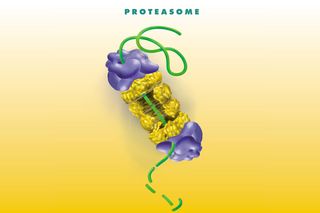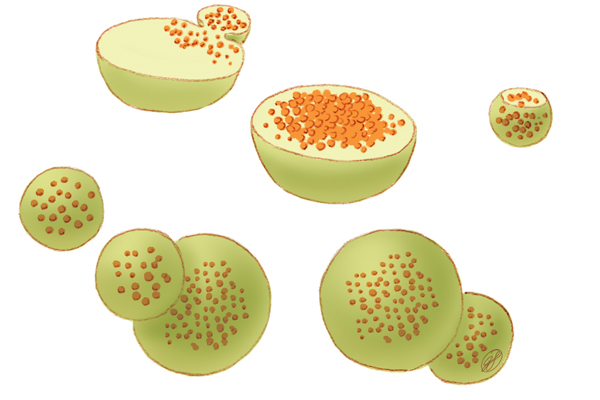Which Organelle Is Responsible For Garbage Disposal And Recycling In An Animal Cell
Cellular Garbage Disposals Clean Up

Cells rely on garbage disposal systems to keep their interiors corking and tidy. If it weren't for these systems, cells could look like microscopic junkyards — and worse, they might non function properly.
So abiding cleaning is a crucial biological procedure, and if it goes wrong, it tin cause serious problems. Scientists funded by the National Institutes of Health are therefore working to understand the jail cell's janitorial services to find means to combat these malfunctions.
Garbage Disposal
One of the jail cell'due south trash processors is chosen the proteasome. Information technology breaks downward proteins, the edifice blocks and mini-machines that make up many cell parts. The barrel-shaped proteasome disassembles damaged or unwanted proteins, breaking them into bits that the cell can re-utilize to make new proteins. In this way, the proteasome is only equally much a recycling plant as information technology is a garbage disposal.
How does the jail cell know which proteins to continue and which to trash? The 2004 Nobel Prize in chemistry went to three scientists for answering that question. They found that the prison cell labels its refuse with a tiny protein tag chosen ubiquitin. Once a protein has the ubiquitin label, the proteasome can grab it, put it within the barrel, pause it down and release the pieces.
Because diseases like Alzheimer's involve the accumulation of excess proteins, researchers are trying to develop medicines to help the proteasome out. They hope such a handling would go along brain cells clean and healthy.
Scientists are also interested in designing medicines that turn off the proteasome. Cancer cells, for instance, make a lot of aberrant proteins that their proteasomes accept to remove. A proteasome-clogging medicine could prevent cancer cells from recycling their own garbage, leaving them without reusable resources for survival and growth. This is the approach behind the proteasome inhibitor drug bortezomib, which is used for the blood cancer multiple myeloma.

Cellular Breadbasket
Proteins aren't the only blazon of cellular waste material. Cells as well accept to recycle compartments called organelles when they get old and worn out. For this task, they rely on an organelle called the lysosome, which works similar a cellular stomach. Containing acid and several types of digestive enzymes, lysosomes digest unwanted organelles in a process termed autophagy, from the Greek words for "self" and "eat." The multipurpose lysosome also processes proteins, bacteria and other "food" the cell has engulfed.
An inability to brand one of the lysosomal enzymes can lead to a rare, life-threatening sickness called a lysosomal storage disease. There are more than 40 different lysosomal storage diseases, depending on the kind of trash that's unprocessed. These diseases can bear upon many organs, including the brain, heart and basic.
Lysosomes too gobble up viruses, an activity important to fighting infections. A drug that activates lysosomes protects mice from diseases like Westward Nile virus. Information technology's possible that the aforementioned or similar medications might treat diseases in which cellular trash piles up, including Alzheimer'southward and other diseases of aging.

Fleck Pile
While cells mainly employ proteasomes and lysosomes, they have a couple of other options for trash disposal.
Sometimes they simply hang onto their trash, performing the cellular equivalent of sweeping it under the rug. Scientists propose that the cell may pile all the unwanted proteins together in a glob called an aggregate to go on them from gumming up normal cellular machinery.
For instance, a protein called islet amyloid polypeptide builds up in aggregates in the pancreas of people with type 2 diabetes. Other proteins form aggregates in certain brain diseases. Scientists are withal trying to understand what these trash piles practice and whether they're helpful or harmful.
If the garbage tin't exist digested by lysosomes, the jail cell tin can sometimes spit information technology out in a procedure called exocytosis. Once outside the cell, the trash may encounter enzymes that can accept it apart, or it may simply form a garbage heap called a plaque. Unfortunately, these plaques outside the jail cell may be harmful, too.
The prison cell as well has ways to toss out some poisons that become inside. This means that cancer cells may pump out cancer drugs that are meant to destroy them, and bacteria may do the aforementioned with antibiotics. Scientists are studying how these pumps work, looking for ways to keep the medicines inside where they can practise their job.
Further written report of the many means cells have out the trash could atomic number 82 to new approaches for keeping them salubrious and preventing or treating illness.
This Inside Life Science article was provided to LiveScience in cooperation with the National Institute of General Medical Sciences, part of the National Institutes of Health.
Acquire more than:
Within the Cell Booklet
Too in this series:
Cilia: Biology'south Brooms
The Amazing Earth Inside a Man Cell
Cell Suicide: An Essential Role of Life
Source: https://www.livescience.com/31966-cells-garbage-disposal-crucial-processes-nigms.html
Posted by: sohimpt1956.blogspot.com

0 Response to "Which Organelle Is Responsible For Garbage Disposal And Recycling In An Animal Cell"
Post a Comment